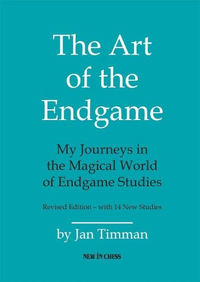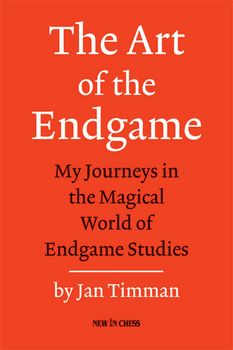| Nivå | C-D |
| Utgivelsesdato | Desember 2011 |
| Forfatter | |
| Pris | 320 NOK |
The Art of the Endgame
My Journeys in the Magical World of Endgame StudiesEn Timman-bok med sluttspillstudier kan høres tungt ut, men så er det i alle fall også svært leseverdige historier om hvordan han selv i 2010-11 har laget nye studier fra tidligere studier og partier fra andres hånd.
Det er en nyere utgave: The Art of the Endgame (utg. 2) [PAPERBACK]
Dette er selvfølgelig mye elegant sjakk, ja kunst som boktittelen sier oss. I tillegg til nytelsen og det artistiske poengterer Jan Timman også at sluttspillstudiene hjalp ham vesentlig på veien til verdenseliten ved sjakkbrettet, der han gjennom mange år var topp-10.
Han er også kjent for flere fremragende bøker, og denne nye er faktisk kandidat til å være den aller beste. Den er mest for spillere med ratingstyrke omlag 13-1400 og opp til det dobbelte...
Kapitlene med ulike typer sluttspillstudier:
- Miniature Studies
- Rook versus Bishop
- Preventing Pawn Promotion
- Various Promotion Combinations
- Knight Promotion
- Bishop Promotion
- Mating Patterns
- Stalemate Patterns
- Mutual Zugzwang
- Building a Fortress
- Systematic Manouvres
- The Disappearing Trick
- Three Themes
- Various Endgame Studies
Timmans personlige forord er også leseverdig:
PDF-utdragIn my early youth, there were fascinations. I imagined how it would be to live in a house in the woods. Castles would bring me to raptures. I remember my excitement when I was standing with my parents on the ferry that transported visitors to Loevestein Castle. I dreamed that on the play ground in our neighbourhood there was a castle you could play in.
In the summer holidays, we travelled along the Rhine in a Ford Taunus – my father be hind the wheel, my mother next to him and we, the four kids, pressed to gether on the back seat. Our destination was Tuscany: Siena and Lucca, with its all-embracing city wall, which we rounded again and again during our long walks.
Along the Rhine stood the robber baron castles with their impressive names: Reichenstein, Rheinfels, and the Fürstenberg, the ruin that towered high above the Rheindiebach village. There we used to find lodgings in a little hotel, concluding the first stage of our trip. At home, in the living room, I would build Lego cities and Citadel castles. M.C. Escher’s ‘Metamorphosis’ starts with black-and-white squares that transform into salamanders. The salamanders become beehives. Out of these, bees emerge, which are ingeniously transformed into birds. Then there are fish, and in the accompanying pattern – birds again. Here the ‘Metamorphosis’ ar rives at things made by hu man hands. The new birds trans form into blocks. Out of these, houses in a South-Ital ian town are formed. Now the systematic pattern of forms is broken. A bridge connects the town with a chess board. On a3 is a white rook, which also exists in the other reality. On the chess board, a position is depicted where White perishes due to a smothered mate. And then Escher is back at the black-and-white squares.
From building miniature cities to chess: this was a step I already made in my youth. The world of chess was the most fascinating. I devoured Euwe’s books. The memory of the game Réti-Alekhine, an notated in his book Practical Chess Les sons, which never ceased to amaze me: the black rook appearing on e3 and remaining en prise there for several moves. Another game that was indelibly printed in my memory was Tartakower-Botvinnik from Hans Müller’s Mikhail Botvinnik, One Hundred Selected Games. It was an impressive image: the white king was pinned down in the corner by a knight on f3, supported by a mighty pawn front.
Within the romantic world of chess there was a sec tor that was even more hermetically closed off from the out side world. I first be came acquainted with it when I read Herbstman’s book ‘De schaakstudie in onze dagen’ (i.e. ‘Contemporary Chess Studies’). In this new world there was no struggle in the sense of a ma n-to-ma n fight. The competitive element was gone – only scientific and artistic elements remained. The studies by Troitzky and Kubbel had a special magic. I felt that their master pieces were made for eternity.
It is the strict regulations that lend a special status to the endgame study. White always has only one move to reach his goal, whether it is to force a win or a draw. Black, on the other hand, may have alternatives, and these extra possibilities can enhance the content and the richness of a study. In practical chess, you think about what lies in the distance. You make plans and calculate variations. Creating an endgame study requires a significantly different thinking process. As a rule, the end game study composer has an end position in mind, which contains a spectacular hidden point. Then co mes the stage of retrograde thinking: he investigates the position back wards, asking him self: ‘What was White’s last move?’ and then: ‘What was Black’s last move?’ To day I still ask myself these questions in my mind.
I composed my first studies in the early 1970’s, when I had just finished my secondary school education and the world was my oyster. Now I look back on this, four decades later, it strikes me how uncomplicated these early pieces of work look. The points are nice, but the play misses the depth of my later studies. Not un til the 1980s did I man age to create a few high-level studies.
Nowadays I can hardly imagine how it was to com pose studies without a computer. In those days it was extremely difficult to work out all the tactical details. You could spend days eliminating little tactical tricks that upset the play. And then some times, there would still re main questions. Now a days you can simply move your pieces and pawns to the right squares on the analysis board of your computer. Tactical snags are often useful for adding new elements to the study.
In December 2010, I decided to write The Art of the Endgame. I wanted to show systematically, guiding the reader along themes and genres, why end game studies are so beautiful and so interesting. Especially the system - The Art of the End game at ics were impor tant. It had struck me that most books on endgame studies were quite random collections. My intention was to reveal the secrets from the world of end game studies in 14 chapters. I also had a second intention: in 1991, my book Schaakwerk II had appeared in Dutch (later translated as Studies and Games). In the second part of this book I had included a number of endgame studies. I wanted to put this material under the microscope one more time. With the help of the computer I would establish if the studies were correct, after polishing them up in some cases.
In January 2011, I started my journey in the world of endgame studies. I kept making new, fascinating discoveries. This stimulated me to create new studies. Before, I had never occupied my self with the question how you could in corporate the Novotny theme and the related Plachutta theme in studies. Studying a number of examples pointed me in the right direction. Never be fore have I been so productive as an end game study composer as in the seven months that I wrote this book. It was a sensational experience. Whether I looked at bishop promotions, systematic manoeuvres, or the Valladao Task, I kept finding new paths. The computer has refuted a number of studies by great composers. Now adays there is a trend to publish such refutations as if they were great achievements. In this book I have striven to use the computer in a constructive way. An impressive work of art that has been damaged, must be repaired with great care. I have treated studies with such defects in the same way. I corrected them in ways that did not affect the brilliant ideas.
In the first chapter I discuss miniature studies, i.e. pieces of work that are of ten closely related to the theoretical side of the endgame. The second chapter continues on this path, and is purely theoretical. Then we come to the real romanticism. Pawn promotion is an important factor in chess. First I discuss several methods to prevent pawn promotions, and after that the various promotion combinations are reviewed. I have given a representative picture of the themes. As with every theme, I can not pretend to be comprehensive; there are more than 75,000 studies in existence!
In the chapter on knight promotions, I have had to restrict myself even further. This is the type of pawn promotion that is most frequent after the regular queening, in practice as well as in studies. I have exclusively dealt with knight promotions that repeat themselves according to a certain pattern. With bishop promotions I could paint a slightly more comprehensive picture again, even though I was forced to make choices here as well.
In the chapters on mate and stalemate, I have selected those studies that appealed to me most. That was anything but easy. Each study (or game) ends in mate or stalemate, and the motifs can be surprising and beautiful. Mutual zugzwang and build ing a for tress are themes that can be of practical use. It is remarkable how of ten strong players do not recognize these themes. For this reason, I think that Chapters 9 and 10 are highly instructive. On the other hand, the next two chapters contain themes that are entirely disconnected from practice. Systematic manoeuvres do not occur in games. Nor will a player strive to lose pieces in the course of a variation. How ever, it is worth while to see how these offerings are justified in studies.
In the chapter called ‘Three Themes’ I have dealt with three of my favourite themes. The final chapter is a collection of remaining studies. Again, I had to make a selection here. There were studies from the past with nice ideas, which nevertheless had to be rejected for publication, either be cause the computer refuted certain variations, or because the variations were insufficiently special.
And that is how my seven months’ journey came to an end. It was not only a fascinating experience, but also an instructive one. It seemed as if I was finally allowed to probe depths in the end game that had been hidden from me before. I have tried to describe and explain my findings as clearly as possible. And I sincerely hope that the depth and beauty of endgame studies will also move the reader.
Jan Timman, August 2011
| Innbundet? | Nei |
| Type | Bok |
| Språk | Engelsk |
| Antall sider | 268 |
Se også
-

The Art of the Endgame
Kjøp- Pris
- 340
- Av
- Utgivelsesdato
- August 2023

